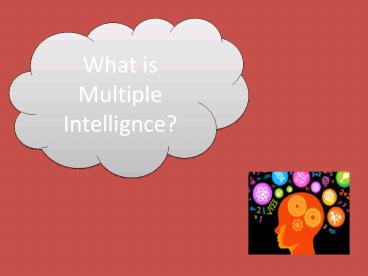Howard Gardner: Multiple Intelligences Theory - PowerPoint PPT Presentation
Title:
Howard Gardner: Multiple Intelligences Theory
Description:
What is Multiple Intelligence? Who develop this theory and what are their several types? – PowerPoint PPT presentation
Number of Views:6110
Title: Howard Gardner: Multiple Intelligences Theory
1
What is Multiple Intellignce?
2
What is Multiple Intellignce?
- The theory of multiple intelligences is Howard
Gardner's theory that proposes that people are
not born with all of the intelligence they will
ever have. - It says that Everyone is intelligent in at least
nine different ways and can develop each aspect
of intelligence to an average level of
competency. - Intelligence , as defined by Gardner, is the
ability to solve problems that are valuable in
one or more cultural settings.
3
What is this theory?
- Breaks down in different "intelligences" to
categorize talents and skills. - Gardner The kinds of intelligence would allow
different ways to teach, rather than one."
4
The Type of Multiple intelligences
- Logical-Mathematical Intelligence.
- Intrapersonal Intelligence.
- Interpersonal Intelligence
- Linguistic Intelligence.
- Bodily-Kinesthetic Intelligence.
- Visual-Spatial Intelligence.
- Musical Intelligence.
- Naturalist Intelligence.
- Existential Intelligence
5
Logical-Mathematical Intelligence
- Ability to explore patterns, categories and
relationships by manipulating objects or symbols,
and to experiment in a controlled, orderly way. - Ability to reason either deductively or
inductively and to recognize and manipulate
abstract patterns and relationships.
6
Intrapersonal Intelligence
- Ability to gain access to understand one's inner
feelings, dreams and ideas. - Personal knowledge turned inward to the self.
This form of intellect entails the ability to
understand one's own emotions, goals and
intentions.
7
Linguistic Intelligence
- Ability to use language to excite, please,
convince, stimulate or convey information. - Involves not only ease in producing language,
but also sensitivity to the nuances, order and
rhythm of words. .
8
Interpersonal Intelligence
- Ability to understand other people, to notice
their goals, motivations, intentions, and to work
effectively with them. - Emphathize with others, observe and understand
othersmoods, feelings, temparament..
9
Bodily-Kinesthetic Intelligence
- Ability to use fine and gross motor skills in
sports, the performing arts, or arts and crafts
production. - Bodily Intelligence involves using the body to
solve problems, to create products, and to convey
ideas and emotions.
10
Visual-Spatial Intelligence
- Ability to perceive and mentally manipulate a
form or object, and to perceive and create
tension, balance andcomposition in a visual or
spatial display. - Ability to create visual-spatial representations
of the world and to transfer those
representations either mentally or concretely.
11
Musical Intelligence
- Ability to enjoy, perform or compose a musical
piece. - Includes sensitivity to pitch, rhythm of sounds,
as well as responsiveness to the emotional
implications of these elements.
12
Naturalist Intelligence
- Ability to recognise flora and fauna, communion
with the natural world and its phenomena. - Involves the full range of knowing what occurs in
and through our encounters with the natural world
including our recognition, appreciation, and
understanding of the natural environment..
13
Existential Intelligence
- Existential Intelligence is concerned with the
inner life of mind and spirit and its
relationship to being in the world. - It implies a capacity for a deep understanding
of existential - questions and insight into multiple
levels of consciousness and also implies
awareness of spirit as the creative life force of
evolution.
14
Concusion
Multiple Intelligence as a Diagnostic Tool
- Asks how are you smart? rather than how smart
are you? - Helps teachers see how students learn
- No competition and does not injure the childs
self-esteem - Helps parents know how to help their kids learn
15
SEEMAS ACAEMY
Thank You !!!
WWW.seemasacademy.com































![[PDF] Frames of Mind: The Theory of Multiple Intelligences Paperback – March 29, 2011 Android PowerPoint PPT Presentation](https://s3.amazonaws.com/images.powershow.com/10075631.th0.jpg?_=20240709085)